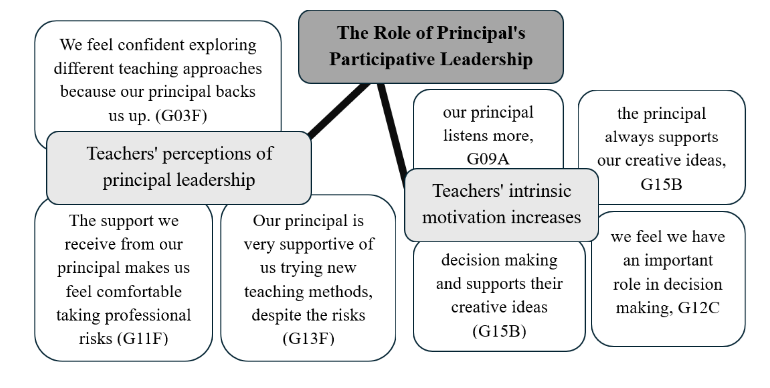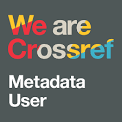The Role of Principal's Participative Leadership in Building Teachers' Intrinsic Motivation: Impact on Learning Quality
DOI:
https://doi.org/10.51574/ijrer.v4i3.3198Keywords:
Intrinsic Motivation, Learning Quality, Principal, Participative Leadership, Teacher EmpowermentAbstract
The improvement of learning quality in Indonesia is greatly influenced by teacher performance and the effectiveness of principal leadership. This study aims to analyze the role of participatory leadership by principals in building teachers' intrinsic motivation and its impact on learning quality. We obtained data using a qualitative approach through in-depth interviews with teachers and principals, along with document analysis. The selection of research subjects used purposive sampling because the subjects had to meet several established criteria. To make the qualitative data easier to understand, thematic analysis was employed in this study's data analysis. The results of the study showed that the implementation of participatory leadership through teacher involvement in decision-making and granting autonomy was positively correlated with increased teacher intrinsic motivation (autonomy, competence, connectedness). We observed that teacher intrinsic motivation contributes to improving learning quality through teaching innovation, student interaction, and the development of relevant materials. The principal's participatory leadership was significant in fostering teacher internal motivation, which had a positive impact on the quality of school learning. The implications of the study emphasize the importance of adopting participatory leadership as a strategy for empowering teachers and improving the quality of education.
References
Adu-Marfo, A. O., Asamoah, M. K., Aryeh-Adjei, A. A., & Miller-Young, J. (2024). Beliefs and factors influencing teachers’ deployment of social media in instructional delivery in public basic schools in a developing and low-tech country. Social Sciences and Humanities Open, 10(July), 101126. https://doi.org/10.1016/j.ssaho.2024.101126
Albadi, N. M., Harkins, J., & O’Toole, J. M. (2018). Recent Reforms in Saudi Secondary Science Education: Teacher and Student Perceptions of Grade 10 Physics. International Journal of Science and Mathematics Education, 1–21. https://doi.org/10.1007/s10763-018-9881-3
Ali, R. (2024). Navigating for smooth sailing: a qualitative analysis of factors affecting institutional adoption and diffusion of blended learning. Policy Reviews in Higher Education, 2969, 212–234. https://doi.org/10.1080/23322969.2024.2404858
Alonso, R. K., Velez, A., Diego Mantecón, M. Á., & Heredia Oliva, E. (2025). Blended learning in higher education for the development of intrinsic motivation: a systematic review. Cogent Education, 12(1). https://doi.org/10.1080/2331186X.2025.2487572
Anselmus Dami, Z., Budi Wiyono, B., Imron, A., Burhanuddin, B., Supriyanto, A., & Daliman, M. (2022). Principal self-efficacy for instructional leadership in the perspective of principal strengthening training: work engagement, job satisfaction and motivation to leave. Cogent Education, 9(1). https://doi.org/10.1080/2331186X.2022.2064407
Burns, E. C., Martin, A. J., & Evans, P. A. (2021). The role of teacher feedback–feedforward and personal best goal setting in students’ mathematics achievement: a goal setting theory perspective. Educational Psychology, 41(7), 825–843. https://doi.org/10.1080/01443410.2019.1662889
Clanton Harpine, E. (2024). Creating an Intrinsically Motivating Learning Environment: Promoting Student Engagement and Intrinsic Motivation. In Service Learning in Higher Education: From Pedagogy to Practice (pp. 59-76). Cham: Springer Nature Switzerland. https://doi.org/10.1007/978-3-031-51378-7_5
David Ng, F. S. (2015). Leadership learning for complex organizations. Cogent Education, 2(1). https://doi.org/10.1080/2331186X.2015.1017312
Dickson, A., Perry, L. B., & Ledger, S. (2021). Challenges of the international baccalaureate middle years programme: Insights for school leaders and policy makers. Education Policy Analysis Archives, 29. https://doi.org/10.14507/EPAA.29.5630
Dugan, K., & Letterman, M. (2008). Student Appraisals of Collaborative Teaching. College Teaching, 56(1), 11–15. https://doi.org/10.3200/CTCH.56.1.11-16
Er, E. (2021). The relationship between principal leadership and teacher practice: Exploring the mediating effect of teachers’ beliefs and professional learning. Educational Studies, 50(2), 166–185. https://doi.org/10.1080/03055698.2021.1936458
Ghamrawi, N., Shal, T., & Ghamrawi, N. A. R. (2024). Cultivating teacher leadership: evidence form a transformative professional development model. School Leadership & Management, 44(4), 413–441. https://doi.org/10.1080/13632434.2024.2328056
Gumus, S., Bellibas, M. S., Esen, M., & Gumus, E. (2018). A systematic review of studies on leadership models in educational research from 1980 to 2014. Educational Management Administration & Leadership, 46(1), 25-48. https://doi.org/10.1177/1741143216659296
Hastuti, E. S., Umam, K., Eclarin, L., & Perbowo, K. S. (2021). Kecemasan Siswa Sekolah Menengah Pertama Dalam Menyelesaikan Masalah Spldv Pada Kelas Virtual. International Journal of Progressive Mathematics Education, 1(1), 63–84. https://doi.org/10.22236/ijopme.v1i1.6914
Holmström, A., Tuominen, H., Laasanen, M., & Veermans, M. (2023). Teachers’ work engagement and burnout profiles: Associations with sense of efficacy and interprofessional collaboration in school. Teaching and Teacher Education, 132, 104251. https://doi.org/10.1016/j.tate.2023.104251
Karim, A., Fathurohman, O., Sulaiman, S., Marliani, L., Muhammadun, M., & Firmansyah, B. (2025). How do principals act as leaders and managers in boarding and public schools in Indonesia? Cogent Education, 12(1). https://doi.org/10.1080/2331186X.2024.2445354
Kaso, N., Aswar, N., Firman, F., & Ilham, D. (2019). The relationship between principal leadership and teacher performance with student characteristics based on local culture in senior high schools. Kontigensi: Jurnal Ilmiah Manajemen, 7(2), 87-98. https://doi.org/10.56457/jimk.v7i2.129
Ke, Z., Yin, H., & Huang, S. (2019). Teacher participation in school-based professional development in China: does it matter for teacher efficacy and teaching strategies? Teachers and Teaching: Theory and Practice, 25(7), 821–836. https://doi.org/10.1080/13540602.2019.1662777
King, F., & Holland, E. (2022). A transformative professional learning meta-model to support leadership learning and growth of early career teachers. International Journal of Leadership in Education, 28(3), 593–617. https://doi.org/10.1080/13603124.2022.2037021
Kriyantono. (2014). Practical Techniques of Communication Research. Accompanied by Practical Examples of Media Research, Public Relations, Advertising, Organizational Communication, Marketing Communication. Jakarta: Kencana, 22(1), 65–70
Kyei-Akuoko, C., Mensah, R. O., Kuusongno, D. D., Ebow Yalley, C., & Darko Amponsah, K. (2025). Evaluation of blended learning: challenges, academic performance shifts, and the pros and cons in a selected Technical University. Cogent Arts and Humanities, 12(1). https://doi.org/10.1080/23311983.2024.2435713
Ledger, S., Vooren, C. Van, Villaverde, A., Steffen, V., & Lai, C. (2016). More than a second language: Leadership structure and pedagogic strategies in an Australian International Baccalaureate PYP additional language program. In Journal of Second Language Teaching and Research (Vol. 5, pp. 6–36). http://pops.uclan.ac.uk/index.php/jsltr/article/view/406
Lie, R., Selcen Guzey, S., & Moore, T. J. (2018). Implementing Engineering in Diverse Upper Elementary and Middle School Science Classrooms: Student Learning and Attitudes. Journal of Science Education and Technology, 104–117. https://doi.org/10.1007/s10956-018-9751-3
Lomba-Portela, L., Domínguez-Lloria, S., & Pino-Juste, M. R. (2022). Resistances to educational change: Teachers’ perceptions. Education Sciences, 12(5), 359. https://doi.org/10.3390/educsci12050359
Long, T., Zhao, G., Li, X., Zhao, R., Xie, K., & Duan, Y. (2020). Exploring Chinese in-service primary teachers’ Technological Pedagogical Content Knowledge (TPACK) for the use of thinking tools. Asia Pacific Journal of Education, 00(00), 1–21. https://doi.org/10.1080/02188791.2020.1812514
Mudjisusatyo, Y., Darwin, D., & Kisno, K. (2024). Change management in Independent Campus program: application of the ADKAR model as a change management competency constructor. Cogent Education, 11(1). https://doi.org/10.1080/2331186X.2024.2381892
Nadeem, M. (2024). Distributed leadership in educational contexts: A catalyst for school improvement. Social Sciences & Humanities Open, 9, 100835. https://doi.org/10.1016/j.ssaho.2024.100835
Pacific Policy Research Center. (2010). 21st Century Skills for Students and Teachers. Kamehameha Schools, Research & Evaluation Division.
Pardosi, J., & Utari, T. I. (2022). Effective principal leadership behaviors to improve the teacher performance and the student achievement. F1000Research, 10, 465. https://doi.org/10.12688/f1000research.51549.2
Parlar, H., Türkoğlu, M. E., & Cansoy, R. (2022). Exploring how authoritarian leadership affects commitment: The mediating roles of trust in the school principal and silence. International Journal of Educational Management, 36(1), 110-129. https://doi.org/10.1108/IJEM-04-2021-0160
Ruengmak, A., & Dejpawuttikul, T. (2024). The emergence of the ‘Ai Khai’ worship and the social revival in post-COVID-19 southern Thailand: the interplay between local folklore and sacred tourism. Cogent Arts and Humanities, 11(1). https://doi.org/10.1080/23311983.2024.2313845
Sanchez, J. E., Paul, J. M., & Thornton, B. W. (2022). Relationships among teachers’ perceptions of principal leadership and teachers’ perceptions of school climate in the high school setting. International journal of leadership in education, 25(6), 855-875. https://doi.org/10.1080/13603124.2019.1708471
Scallon, A. M., Bristol, T. J., & Esboldt, J. (2023). Teachers’ perceptions of principal leadership practices that influence teacher turnover. Journal of Research on Leadership Education, 18(1), 80-102. https://doi.org/10.1177/19427751211034214
Scroll, P., & For, D. (2014). An APOS analysis of natural science students’ understanding of integration. Journal of Research in Mathematics Education, 3(1), 54–73. https://doi.org/10.4471/redimat.2014.40
Sy, S. H. (2022). Urgensi Mutu pada Lembaga Pendidikan. Ideas: Jurnal Pendidikan, Sosial, dan Budaya, 8(3), 697-706. https://doi.org/10.32884/ideas.v8i3.841
Tamphu, S., Suyitno, I., Susanto, G., Budiana, N., Salim, M. R., Nurhikmah, & Purnawati, W. (2024). Building bridges to the future of learning: Exploring artificial intelligence research using R-Studio assisted bibliometrics. Cogent Education, 11(1). https://doi.org/10.1080/2331186X.2024.2417623
Wang, D., & Zhang, L. J. (2021). Sustainability as a goal in teaching workforce retention: exploring the role of teacher identity construction in preservice teachers’ job motivation. Sustainability, 13(5), 2698. https://doi.org/10.3390/su13052698
Yalçınkaya, S., Dağlı, G., Altınay, F., Altınay, Z., & Kalkan, Ü. (2021). The effect of leadership styles and initiative behaviors of school principals on teacher motivation. Sustainability, 13(5), 2711. https://doi.org/10.3390/su13052711
Zhang, X., Admiraal, W., & Saab, N. (2021). Teachers’ motivation to participate in continuous professional development: relationship with factors at the personal and school level. Journal of Education for Teaching, 47(5), 714–731. https://doi.org/10.1080/02607476.2021.1942804

Downloads
Published
How to Cite
Issue
Section
License
Copyright (c) 2025 Erna Kusumawati

This work is licensed under a Creative Commons Attribution-ShareAlike 4.0 International License.









1.png)













